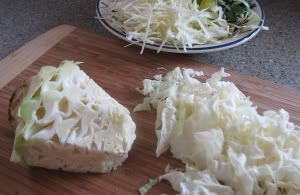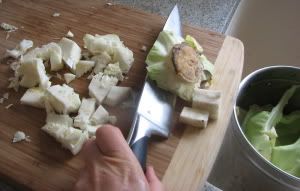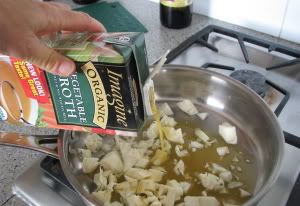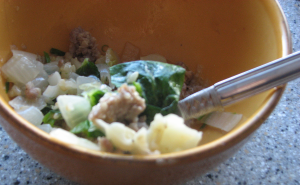4 Tricks for Taking the Sting Out of Bitter Vegetables
There’s a reason grocery store displays of broccoli rabe, rutabagas and turnips go

untouched for hours at a time. Some members of the vegetable kingdom are just a little harder to like than others. But we still want the flavor and nutrient diversity they offer. Happily, there are ways of preparing these difficult specimens that make them more palatable. Although the following article focuses on cabbage cores, a particularly challenging vegetable, its tricks can be used to form a good working relationship with any of the harsher vegetables.
Here’s an honest admission: I have a “waste-not-want-not” thing going on. My Twitter column is filled with vegetable dishes fast enough for breakfast and lunch—a good many made with stems, stalks, cores and leaves that normal cooks would pitch. But not me. I have this thing about waste, so I set myself a personal goal of starving my compost pile as much as possible.
To date, things have been going pretty well. I’ve been turning kale stems, cauliflower leaves, broccoli stalks and other such “refuse” into tasty dishes—boosting my vegetable intake and stretching my vegetable dollars. But then came yesterday’s cabbage core. Couldn’t I safely pitch that without violating my self-inflicted waste code?
Tasting a piece of it triggered deep, gastronomic memories of everything bad about cabbage. I now knew why the cabbage itself was unbelievably sweet and light: Every bit of the head’s strong, musky, sour and harsh taste had been sucked into the core! And that foul taste is what I got upon testing a bite.
I immediately started to scrape the whole thing towards the compost bin. Not until the last

second did my better self rise to the occasion. The compost bin got the moldy end of the core (I do have some limits!), but the rest got chopped as I decided how to transform it into something I could stomach. Working with vegetable parts that are frequently discarded, I’ve learned a few tricks to render them not only palatable but pretty decent-tasting. This core was about to be my biggest challenge to date.
Trick 1: Cook It Cooking is the best way to extract the bitterness from a vegetable. In this case, I didn’t even consider steaming or sauteing but went straight to boiling, which is the preferred cooking method for really tough vegetable characters.
I know that boiling has lost favor over the years, probably because we get vegetables shipped in year round that are tender enough for just a light steaming or sautéing, which is generally better taste wise and nutritionally. But imagine a pioneer farm wife faced with some garden remnant in November—it may be tough and gnarly, but it’s the closest thing to fresh that she will have for four months. She is going to make those stalks or stems taste good no matter what, and boiling is the tool for the job.
Note, however, that boiling isn’t limited to throwing vegetables in a huge pot of water, cooking the vegetables to death and then pitching the water. On the contrary, I simmer rather than boil my vegetables in a tiny, not a potful, of liquid. This means any leached out vitamins and minerals get concentrated in an amount of liquid small enough that it can be fully incorporated into the finished dish, minimizing nutrient and flavor loss. Also, I only simmer until the vegetables have lost their bitter or harsh taste, which is often when they are still crisp-tender. My cabbage core had to be cooked beyond crisp-tender, but still far short of mush, before losing its harsh taste.
Trick 2: Inject Flavor While water certainly works as a cooking liquid, experiment with

different broths. They can inject flavor into the spaces left by the extraction of the vegetable’s bitterness. I used Imagine’s Vegetable Broth, which has plenty of flavor to spare.
Third: Salt Salt is also good at both drawing out bitterness and imparting flavor. Your broth might be salty enough as is, but if using a low-sodium variety or water, try adding a little (maybe 1/4 tsp. to 1/2 tsp.) of good sea salt. I used about 1/4 tsp. of Celtic salt in my simmer water.
Fourth: Combine with Other Flavorful Ingredients.
I always say that sausage is a miracle ingredient. Add just a little and the entire dish tastes great—no work, little cost and no cooking knowledge required. Sausage was the primary tastemaker I added to my simmered cabbage core.

I also added sweetly browned onions and sweet snap pea shoots (I rescued a few from thegarden before last week’s snow.) Their sweetness balanced the trace amounts of bitterness left in the cooked core pieces, as would other sweet vegetables (red peppers, corn, etc.) or sautéed fruits (like pears and apples), or just rice, chicken, tofu or some kind of sauce with a little sweetness.
The end result? I think I met the challenge with a delicious for lunch that wasn’t just another sandwich–not by a long shot!

Great article! I too have a waste not want not attitude about my veggie leavings. I just finished processing 10 heads of cabbage ito make sauerkraut. I had set aside all the cores. I then decided to pack them all and into a 1/2 gal mason jar and made a brine of 2 tablespoons of sea salt in 1 qt of water and poured it into the jar. I placed a placed a plastic mason jar lid modified with an airlock on top. I figured, if The cabbge can ferment this way, why not the cores?!?
I’ve done this with cauliflower with great results!
Just a note, the cabbage was very fresh and the cores were sweet when I ate a couple of them raw.
I will let them sit at room temp for about a month before I sample them. Wish me luck!
You really one-upped me here! Thanks for sharing this waste-not idea. It was a good update to the post since back in ’09 the fermenting craze hadn’t hit. You’ve got me motivated to get on the bandwagon as fermenting isn’t something I’ve done too much. But a new mason jar lid on the market might help. Wonder if it’s like your modified lid? And I do wish you lots of luck. Please let us know how it goes!